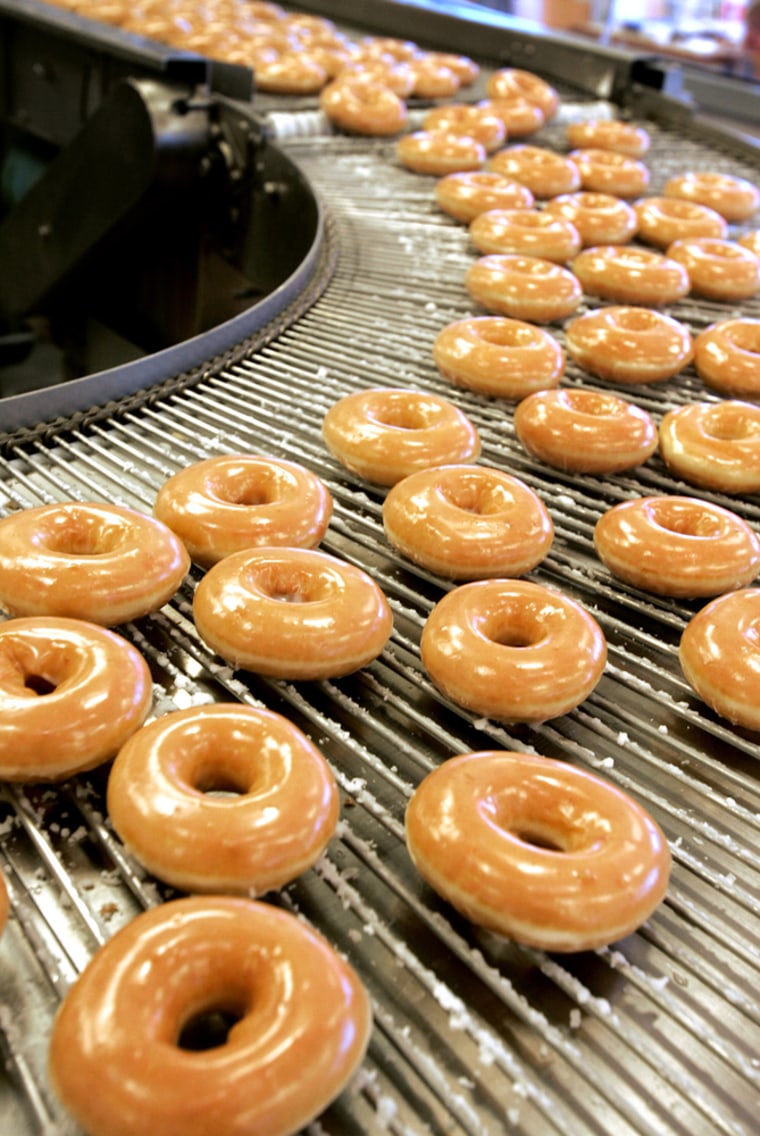Buried deep in Krispy Kreme Doughnuts Inc.’s annual report, released this week after months of delay, was a startling revelation: People aren’t lining up as often for the once trendy treats — sales have dropped more than 18 percent in each of the last two years.
Yes, Krispy Kreme is still trying to find its way out of an accounting mess that’s kept it from reporting quarterly earnings on time during those two years. But it’s the plummet in sales — nearly unheard of among established restaurant chains — that presents the biggest long-term challenge for the maker of the famous “Hot Now” doughnuts.
“I cannot think over the years whose trends would have been that bad in such a short period of time,” said Robert Derrington, a senior restaurant analyst with Morgan Keegan & Co., which does not own, trade or follow Krispy Kreme shares. “The question becomes, can they turn things around?”
The Winston-Salem-based company stopped short of promising such a reversal in the report for fiscal 2006, due July 31 but filed Tuesday night.
“We are in the process of re-evaluating our business and have taken steps to improve our sales,” the company wrote. “There can be no assurance, however, that these steps will produce the desired results.”
There are any number of reasons behind the decline in the popularity of Krispy Kreme’s glazed doughnuts, which once inspired block-long lines whenever the company would open a new location. Analysts said the push that started in 2004 to open new stores undercut the scarcity that once drove the doughnut’s desirability. It also arrived at the height of the low-carb diet craze.
“It got to the point where people could get a Krispy Kreme doughnut anywhere, and consumers weren’t craving it anymore,” said Darren Tristano, executive vice president of Technomic Inc., a Chicago-based food service industry research and consulting firm.
More recently, public health officials in some cities have launched efforts to ban trans fatty acids — a key ingredient in Krispy Kreme’s fried treats. Canton, Mass.-based Dunkin’ Donuts has also made a strong move into the Southern market that was once Krispy Kreme territory, increasing competition in the breakfast treat market that includes Canada’s Tim Hortons.
According to the 2006 annual report, average weekly sales per store — a number that includes sales at Krispy Kreme stores where the doughnuts are made on-site and at locations where pre-packaged doughnuts are sold — decreased 21.9 percent from fiscal 2005 to fiscal 2006, after declining 18.6 percent in the previous year.
While sales were slipping, Krispy Kreme executives were preoccupied with sorting out the accounting mess. A stock that once traded above $50 bottomed out last year around $4, and the company’s board ousted two former executives it concluded were trying to “manage earnings” to meet Wall Street expectations.
While the company has reached a tentative $75 million settlement of a securities class action lawsuit, investigations by the federal Securities and Exchange Commission and federal prosecutors in New York remain unresolved. The company has yet to file six quarterly earnings reports, dating as far back as the fiscal 2005.
For fiscal 2006, the company reported revenues of $543 million and a net loss of $136 million. A year earlier, Krispy Kreme lost $198.3 million on revenue of $707.8 million.
“It is our belief that these numbers are archaic and have little to do with the company’s future,” said Prudential Equity Group analyst Howard W. Penney in a research note issued Wednesday. “Importantly in our view, fiscal 2006 represents a year in which the company was not focused on improving operational efficiencies, but rather correcting the errors of the past.”
The company is now led by Daryl Brewster, a food industry veteran from Kraft, who assumed Krispy Kreme’s chief executive role in March. He’s getting help from a pair of former tobacco executives, one joining the company’s board and the other signing on as general counsel.
“They should have management in place to help fix the problem,” Derrington said.
The company’s annual report cautioned investors that the new executives need time to become familiar with each other and the business, and their efforts “have been hindered at times by a lack of institutional knowledge.” Still, Tristano said, there are some obvious things the company should try to boost sales.
“They have to broaden their offering, they have to find ways to increase the sales of specialty beverages,” said Tristano, adding that Krispy Kreme may want to consider additional food offerings. “We’ve seen a lot more competition on the breakfast front, and right now they are not a major player.”
